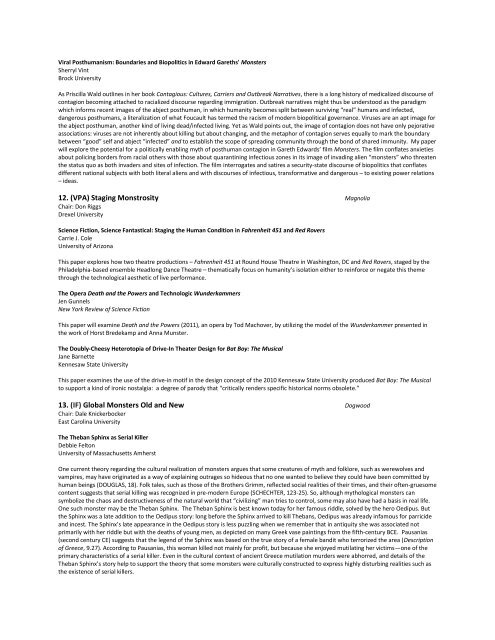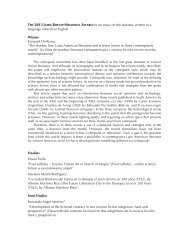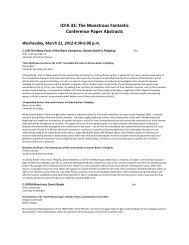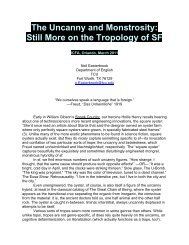The Monstrous Fantastic Conference Paper Abstracts - International ...
The Monstrous Fantastic Conference Paper Abstracts - International ...
The Monstrous Fantastic Conference Paper Abstracts - International ...
Create successful ePaper yourself
Turn your PDF publications into a flip-book with our unique Google optimized e-Paper software.
Viral Posthumanism: Boundaries and Biopolitics in Edward Gareths' MonstersSherryl VintBrock UniversityAs Priscilla Wald outlines in her book Contagious: Cultures, Carriers and Outbreak Narratives, there is a long history of medicalized discourse ofcontagion becoming attached to racialized discourse regarding immigration. Outbreak narratives might thus be understood as the paradigmwhich informs recent images of the abject posthuman, in which humanity becomes split between surviving “real” humans and infected,dangerous posthumans, a literalization of what Foucault has termed the racism of modern biopolitical governance. Viruses are an apt image forthe abject posthuman, another kind of living dead/infected living. Yet as Wald points out, the image of contagion does not have only pejorativeassociations: viruses are not inherently about killing but about changing, and the metaphor of contagion serves equally to mark the boundarybetween “good” self and abject “infected” and to establish the scope of spreading community through the bond of shared immunity. My paperwill explore the potential for a politically enabling myth of posthuman contagion in Gareth Edwards’ film Monsters. <strong>The</strong> film conflates anxietiesabout policing borders from racial others with those about quarantining infectious zones in its image of invading alien “monsters” who threatenthe status quo as both invaders and sites of infection. <strong>The</strong> film interrogates and satires a security-state discourse of biopolitics that conflatesdifferent national subjects with both literal aliens and with discourses of infectious, transformative and dangerous – to existing power relations– ideas.12. (VPA) Staging Monstrosity MagnoliaChair: Don RiggsDrexel UniversityScience Fiction, Science <strong>Fantastic</strong>al: Staging the Human Condition in Fahrenheit 451 and Red RoversCarrie J. ColeUniversity of ArizonaThis paper explores how two theatre productions – Fahrenheit 451 at Round House <strong>The</strong>atre in Washington, DC and Red Rovers, staged by thePhiladelphia-based ensemble Headlong Dance <strong>The</strong>atre – thematically focus on humanity’s isolation either to reinforce or negate this themethrough the technological aesthetic of live performance.<strong>The</strong> Opera Death and the Powers and Technologic WunderkammersJen GunnelsNew York Review of Science FictionThis paper will examine Death and the Powers (2011), an opera by Tod Machover, by utilizing the model of the Wunderkammer presented inthe work of Horst Bredekamp and Anna Munster.<strong>The</strong> Doubly-Cheesy Heterotopia of Drive-In <strong>The</strong>ater Design for Bat Boy: <strong>The</strong> MusicalJane BarnetteKennesaw State UniversityThis paper examines the use of the drive-in motif in the design concept of the 2010 Kennesaw State University produced Bat Boy: <strong>The</strong> Musicalto support a kind of ironic nostalgia: a degree of parody that “critically renders specific historical norms obsolete.”13. (IF) Global Monsters Old and New DogwoodChair: Dale KnickerbockerEast Carolina University<strong>The</strong> <strong>The</strong>ban Sphinx as Serial KillerDebbie FeltonUniversity of Massachusetts AmherstOne current theory regarding the cultural realization of monsters argues that some creatures of myth and folklore, such as werewolves andvampires, may have originated as a way of explaining outrages so hideous that no one wanted to believe they could have been committed byhuman beings (DOUGLAS, 18). Folk tales, such as those of the Brothers Grimm, reflected social realities of their times, and their often-gruesomecontent suggests that serial killing was recognized in pre-modern Europe (SCHECHTER, 123-25). So, although mythological monsters cansymbolize the chaos and destructiveness of the natural world that “civilizing” man tries to control, some may also have had a basis in real life.One such monster may be the <strong>The</strong>ban Sphinx. <strong>The</strong> <strong>The</strong>ban Sphinx is best known today for her famous riddle, solved by the hero Oedipus. Butthe Sphinx was a late addition to the Oedipus story: long before the Sphinx arrived to kill <strong>The</strong>bans, Oedipus was already infamous for parricideand incest. <strong>The</strong> Sphinx’s late appearance in the Oedipus story is less puzzling when we remember that in antiquity she was associated notprimarily with her riddle but with the deaths of young men, as depicted on many Greek vase paintings from the fifth-century BCE. Pausanias(second century CE) suggests that the legend of the Sphinx was based on the true story of a female bandit who terrorized the area (Descriptionof Greece, 9.27). According to Pausanias, this woman killed not mainly for profit, but because she enjoyed mutilating her victims—one of theprimary characteristics of a serial killer. Even in the cultural context of ancient Greece mutilation murders were abhorred, and details of the<strong>The</strong>ban Sphinx’s story help to support the theory that some monsters were culturally constructed to express highly disturbing realities such asthe existence of serial killers.





